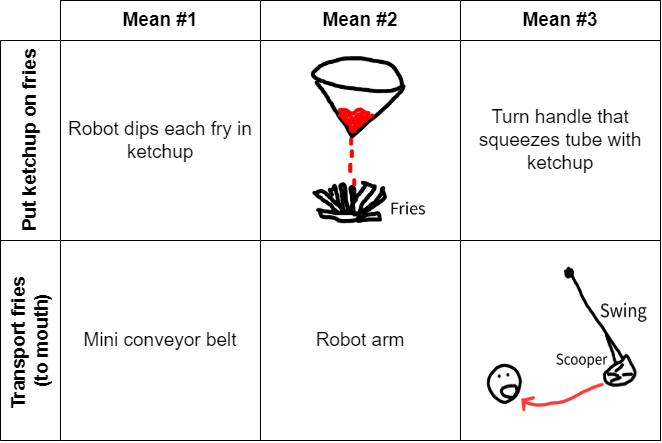Design Process Application
Reviewing Design Terminology
Most probably, you have already used the term “function”, meaning something the design is supposed to DO or accomplish (often verb-noun pairs). This is different from objectives, which focus on qualities the design should have (often adjectives). For our purposes, we have been looking at designs that function like nature! The different possible ways we can accomplish those functions are called “means”. These means are our design choices. They are possible solutions.
As part of the idea generation process, functions and related means can be organized in a morphological chart (sometimes called morph chart). First, we figure out what we want our design to be able to do (functions), and then we come up with many different ways (means) for accomplishing each function. If we just designed based on the first thing that came to mind and did not generate multiple means, we would not be exploring our design space enough. The first solution is not always the best!
Means can be sketched, briefly described, a combination of both, or whatever helps you visualize and organize your ideas.
For example, let us say that I am designing a system that covers my fries in ketchup and feeds me without me directly putting the fries in my mouth. A very simple morphological chart may look something like this:

These charts can have many more functions and many more means depending on your design space, and not all functions need to have the same number of means! We can use this chart by picking one or more means from each function and combining them into preliminary designs.
Applying Biomimicry in Design
Now that we understand what biomimicry is and the relevant design terminologies and tools used in idea generation, we can learn how biomimicry can be incorporated in the design process. Everything has been leading up to this moment.
Watch Biomimicry in design in full screen.
Example of Biomimicry in Design
Let us explore that bicycle “helmet” design and generate some ideas while applying biomimicry. Keep in mind that your own design projects will most likely be more in depth, involving more functions and means than this simple example.
Watch Examples of biomimicry in design in full screen.
Reminder: You can access the Biomimicry Institute’s AskNature tool here: https://asknature.org/
References
Dym, C. L., & Little, P. (2004). Engineering design: A project-based introduction. New York: John Wiley.

